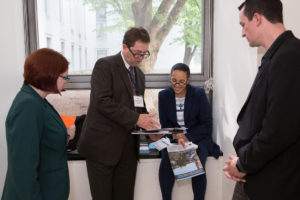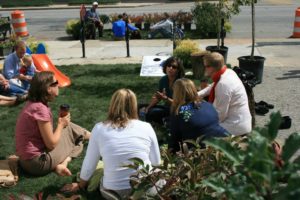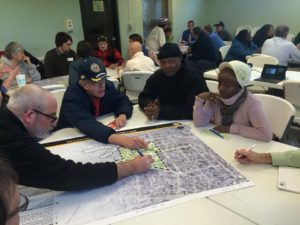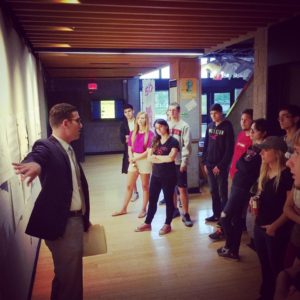By its nature, design evolves, responding to both context and conscious. Reflecting on the prestige and tumult of 2017 (there’s too many to list), has me wondering what the next iteration of landscape architecture will be. What’s on the horizon? What are the groundswell moments that will continue to gain momentum, and what are the emerging challenges that we must confront? From the continued ripples of the LAF Declaration to finding legislative footholds to the powerful Black in Design conference, 2017 was the year that landscape architects awoke to find value in participation beyond practice as well as placing continued emphasis on of the role of place in justice, economics, and environmental stability. In no particular order, here are 5 topics that are permeating the profession of landscape architecture right now.

Design practice has never fit into a box and is employing community engagement strategies with increasing success.
Hybrid Practice
Hybrid practice, alt-practice, adapting practice – no matter the term, the accumulative value of non-traditional design methodologies is a topic gaining increasing traction for landscape architects. In a recent Land8 article, I wrote:
“As society responds to inconstancy in economic, social, and environmental change, the necessity for ‘good design’ continues to adapt and become more prevalent, it is essential to engage in a new process of design, for both personal and professional gain. Tactical Urbanism and its myriad of low cost, temporary design approaches and its contemporaries (Project For Public Spaces and lighter, quicker, cheaper), spurred a different way of thinking about design. It is a subtle difference between human-centric, capacity building approaches and the more common problem-solving based processes, but far more participatory and responsive to end users. Increasingly, these non-traditional techniques are finding a foothold in design, but what role do designers have in rogue design? Already, as financial constraints for clients and communities have tightened, landscape architects have had to find a way to sustain their organizations. Small practitioners in particular have had to be nimble, identifying unique and profitable markets separate from developing drawings.”

Hybrid practice themed presentations at the ASLA Annual Meeting are becoming more and more common.
While the role of traditional landscape architecture continues to adapt and evolve, what remains clear is the increasing value of cross-disciplinary collaboration, understanding the transferable skills of the profession, and developing new methods to practice.

INASLA representatives discuss the legislative priorities of landscape architects with policymakers.
Advocacy and Activism
Prioritizing advocacy and activism within practice has very real economic implications. These include everything from marketplace perception (how genuine are your convictions and how does that prove what you’re good at) to leveraging potential tax credits (volunteer hours and in kind donations) to the legitimate funding of the product of landscape architecture and the impact of regulation on places and small businesses. Government affairs initiatives can lead to substantial economic gain and strengthen the impact of landscape architects. McKinsey and Company notes, “The business value at stake from government and regulatory intervention is huge: about 30 percent of earnings for companies in most industries.” That figures roughly $630M in potential impact to landscape architecture design services nationally, using figures from a 2015 NEA Report.
Landscape architects have had a hell of a year confronting nonstop deregulation battles to continual challenges to the funding that keeps landscape architects employed. According to ASLA’s Government Affairs team, from 2010 to 2015 there were 26 challenges to landscape architecture licensure. In 2017, there were over twenty, in some form or another. Unfortunately, this trend looks to continue threatening an uncertain financial foothold. Only further activism and advocacy will strengthen the position of the profession.

Parks are community infrastructure too.
Community Infrastructure
Infrastructure is the most bipartisan issue in the United States right now. It’s hard to disagree with bridges and roads literally crumbling underneath us. Decades of deferred maintenance have come home to roost and only substantial investment will mitigate what could be catastrophic impact to industry and the public. State DOTs still shape many municipal standards, from which design software is preferable to whether or not to add fiber mesh to sidewalks.
As this reinvestment runs the bureaucratic gamut, landscape architects have the opportunity to inject themselves into the conversation, leading to better ways to design this infrastructure and the systems that infrastructure impacts (stormwater management, ecologic systems, public health, etc.). The rise of groups like NACTO will only strengthen the role of landscape architects in this dialogue, espousing design standards landscape architects have long advocated, such as pedestrian-oriented design.
With the dawn of new technology that will reshape society’s experience of infrastructure, such as the way that self driving cars will begin to shape roadways, municipalities cannot employ the same engineering standards. With advocacy and demonstrated alternative tactics, landscape architects can contribute to a remaking of community infrastructure with once in a generation opportunities to improve the way our cities work. Think integration, not sprawl. The anti-Apple campus.

South Bend residents discuss land use options for adjacent open space at public planning meeting.
Community Driven Design
All of the marches and protests of late 2016 and throughout 2017 lead to a deeper expectation of all of our public spaces. As Fast Company recently pointed out, the implications of boutique urbanism are appropriately being reevaluated. This shift toward community-centric design isn’t new; design firms like IDEO and Greater Good Studio have long championed the process of placing users at the forefront. At the same time, small landscape architecture firms have lived off of 5-year Master Plans for Parks Departments over the last few years, all with required community feedback components. This time, though, landscape architects have the opportunity to stress their expertise in public engagement and let that drive the direction of public space design rather than simply checking boxes and supplying a catalogue of unheeded feedback. Designing with, not for.
Geared toward supporting capacity rather than simply projecting solutions to problems, empathetic design hopefully ushers in an era of more equitable public spaces.

The tools landscape architects have long used will be important in how we address climate change.
Climate Responsive Design
From wildfires to hurricanes, 2017 was a devastating year regarding climate-related natural disasters. Whether or not you think climate change is a result of human industry, design responses to those disasters will be decidedly human led. Simply adding more and more funds to FEMA is unsustainable. The engineered strategies of the last five decades have created as many problems as they have solved, signalling an important rise in solutions that landscape architects have long espoused. Whether or not the profession can capitalize on our marketplace positioning remains to be seen. Comparably minuscule numbers undermine that opportunity, a fact both lamented and bolstered in the LAF Declaration book.

From juries to advisory boards, find a way to get involved and join the fray.
5 Things To Start Doing Right Now:
- Practice grit advocacy: the day-to-day hustle; don’t settle for the base level design standards and challenge the status quo.
- Practice empathetic design. Much of the process of landscape architecture deals with the human impact on the environment. Embrace the embodied ethics of the profession. Stewardship is a conviction, not a trend. Meaning, show don’t tell.
- Design like you give a damn. The billable hours and productivity driven mindset places limitations on the already undervalued design process. Show some initiative and work beyond those limitations, if not for your clients, for yourself.
- Future proof the profession: Describe your practice and yourself in terms of transferable skills, especially as new fields, collaboration opportunities, and areas of practice emerge.
- Facilitate the intersection of theory and practice. Find out what the kids are talking about. Research, read, and get involved. Even if you don’t have a design school nearby, sit on an awards jury (which are often teleconferences) or just call your alma mater and see what’s new. Innovation is born at the intersection of theory and real life practice.
Lead Image: SB150 celebration utilized a 25,000sqft pop-up park to connect major festival locations, while also leveraging interactive elements to increase the vitality of the event.
Published in Blog, Cover Story, Featured



J. Robert (Bob) Wainner
Jonathan………You forgot to mention one of the most DOMINANT “Landscape Architecture Trends for 2018″……..How EXTREMELY LIBERAL “landscape Architecture” is becoming!! It’s the SAME trend that ASLA.org has been following for the past (8) years. There’s nothing wrong with “change”…new ideas and doing all we can to ensure the Landscape Architecture profession continues to have a strong voice in America’s future……..but, your LIST of TRENDS is “in my opinion” coming from a very LIBERAL point of view.
3dpraxisstudio
interesting post..! interesting post!
Pingback: 5 Trends Shaping Landscape Architecture in 2018 – GCA International, LLC – A/E Executive Search – Frank J Rivelli Executive Search Consultant GCA International, LLC | A/E Executive Search